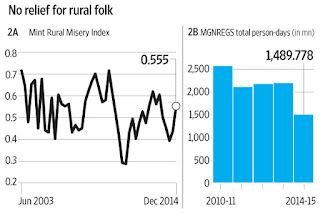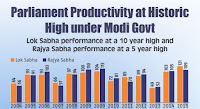Introduction
The former Gujarat Chief Minister Narendra Modi rode his way to power at the centre banking on the strong anti-incumbency trend of the previous Congress-led United Progressive Alliance (UPA) government and his personal charisma. During the days of hectic campaign for his parent party Bharatiya Janata Party (BJP), he often spoke about the "bad days or bure din" of UPA misrule and "ache din or good days" of stable governance to the electorate. A year has gone past since then. It is worthwhile to make a reality check on this claim. Has the ache din come?
Analysis of Narendra Modi Government
Let us give a bail out at the onset to the Narendra Modi-led National Democratic Alliance (NDA) by stating that it is very difficult to judge the performance of the government in a year’s time as many of the measures taken by it will take time to show the discernible result in the society. Yet, we will look into some of the perceivable changes in the approach that we have seen over a year’s time. In this blog, we will just briefly list out those changes.
- Foreign Visits: In his one year’s stay in power, the Prime Minister has taken a large number of visits to foreign countries. It all started with an official visit to Bhutan. Since then, he has traveled to as many as 18 countries. During those visits, he invited the investors in those countries to invest in our country and take part in his pet scheme ‘Make in India’. He also told about the steps he would take to bring more investments in the country such as reducing red-tapeism, nepotism, single-window clearance of new start-ups, etc.

- Rural Performance Index: This is the factor that determines the overall situation in the country as ours is predominantly agrarian country. This index is calculated by measuring the farm output growth, rural wages and tractor sales. This index stooped down in the first year of Modi’s rule. Moreover, Mahatma Gandhi National Rural Employment Scheme (MGNRES) allocation for the current year got reduce, resulting in low wages or non-payment of wages. This also has deteriorated under Modi’s rule.

- Social Sector Allocation: Over the period of 10 years, the social sector spending as a percentage of Gross Domestic Product (GDP) has fallen to the rock bottom. The BJP has spoken out about allocation of fund in this sector in its manifesto. In tune with this, NDA government has rolled out three landmark schemes. They are Pradhan Mantri Jeevan Jyoti Yojana, Atal Pension Yojana and Pradhan Mantri Suraksha Bhima Yojana. These schemes aim to provide accidental death and disability risk cover. These schemes pooled up a sizeable total for spending in social sector.

- Rejuvenated Private Sector: There has been sudden spurt of activities in the private sector due to the business-friendly policies rolled out by the government in the current year’s budget. Recently, the budget airline IndiGo placed an order worth Rs. 1.5 trillion to acquire new aircrafts. However, how long the present positive climate will sustain is a pertinent question. This especially so when we look at the current corporate earnings and capital goods order flow. These factors are not providing an encouraging view. We have to wait and watch to see which way things move.

- Parliamentary Activity: This government has made sure that the attendance levels of members of parliament surpassed the benchmark set up by the previous UPA government. In the first half of the Manmohan Singh dispensation’s rule, there was some productivity due to the tabling of various bills. However, it was a different game altogether as that government could not cobble up numbers in Lok Sabha to get them passed. In this front, Modi government scored over Manmohan government as it could many bills passed. Another indicator of the performance of the Members of Parliament (MPs) in both the houses of Parliament. Many MPs took part in active and productive discussions relating to the legislations affecting people.

- More Power to States: In accordance with the suggestion of 14th finance commission, the Modi government has increased the fiscal autonomy for the states. He gave as much as 74.1% of Union tax money to the state to organize its own local projects. However, it is not the highest share ever given to the state. In 2006, the stages enjoyed the maximum share of 77% of Union tax returns. Yet, it is a welcome signal.

- Financial Inclusion: In order to facilitate director transfer of funds to people availing the subsidized cylinders, the Narendra Modi government has started Pradhan Mantri Jan Dhan Yojana. This scheme enabled common people to open up a bank account for just Rs. 15. This enabled them to get the money from Oil Marketing Companies (OMCs) to come into their accounts. Previously there used to lot of glitches in fund transfers. The government of the day plans to link these account with other welfare schemes to effect speedy transfer of amounts to people, surpassing intermediaries.

- Drying of Foreign Investment: The Indian Prime Minister Narendra Modi had rod on high expectations to come to the corridors of power at the centre. It was discernible even in the stock market. When his office was inaugurated, the SENSEX zoomed in numbers showing a positive recovery. The amelioration of environment was further helped by falling global crude prices, easing inflation and smaller fiscal account deficit. However, due to the poor weather and weak demand has become dominant over other good fiscal indicators. Hence, the Foreign Institutional Investors (FIIs) and Foreign Director Investors (FDIs) have started fleeing from the Indian market as find it difficult to do business in our country with the stranglehold of government agencies still in existence.








1 Post a Comment:
Detailed Review
Post a Comment